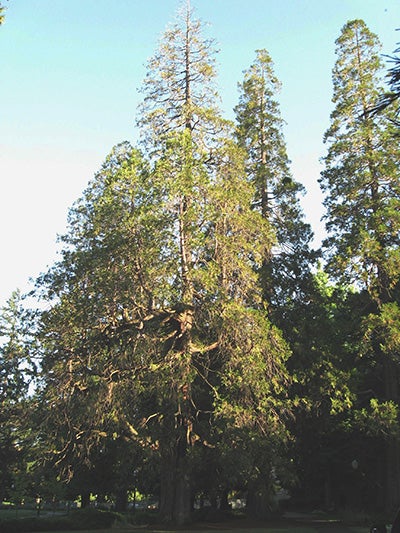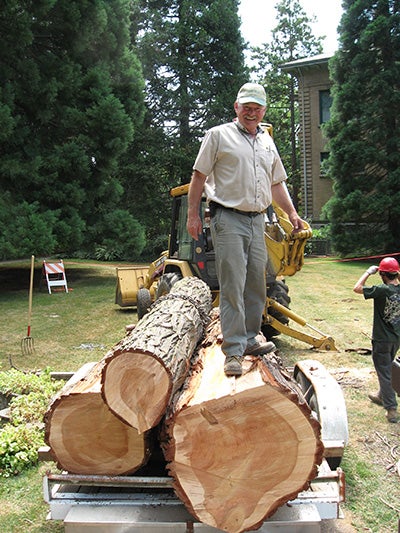Few people think about trees having careers, but UO Arborist John Anthony does. So when UO Campus Tree #285 started looking ill in 2008, Anthony kept his eye on it. It was starting to lean, the color of its foliage wasn’t good, and on close inspection Anthony discovered its top was dying. On a campus where thousands of people walk beneath trees daily, a dying tree is a dangerous tree.
A California Incense Cedar (Calocedrus decurrens), Tree #285 spanned four feet in diameter and soared 130 feet tall at the height of its first career, standing between Deady and Fenton Halls. In August 2009, it was cut down.
Career options for trees expand wildly once they’re horizontal. Native Americans employed incense cedars in second careers as baskets, bows, and fire starters. Euro Americans use them for fences, roofs, guitars. And pencils, lots and lots of pencils.
Tree #285 found a unique encore career: as sixty-eight slats supported by twelve 92-year-old cast iron bench supports. The original bench slats had long ago rotted away, but on the back of one remnant plank was a thin, tarnished brass plaque that, when cleaned up, read “Presented By Class of 1923 University of Oregon.”
“I first saw the plaque on an old broken down bench stuck out back behind my shop,” says Deaton Love of the discovery behind his Quonset hut at the Physical Plant. “I thought, ‘This looks old.’ I cleaned them up and was able to kinda read the plaque—I wasn’t sure if it was 1923 or 1922.”

Above: One of the original benches, the original plaque faintly visible in the center of the topmost slat.
Love, the Trades and Maintenance Coordinator for Campus Operations, had worked with Historic Preservation Program students years earlier when they restored the 1885 Normal Gates in front of Robinson Theatre. After he spotted the relic bench parts, Love contacted Historic Preservation Program Director Kingston Heath, hoping to interest a new crop of students in the bench project. Time went by; years went by, waiting for the right preservation student team.
“Every once in a while I’d send out an email wondering what became of the benches,” Love says. “Finally Brian contacted me.”
Brian is Brian McBeth, a master’s candidate in the Historic Preservation Program. He’s also a former president of the Home Builders Association of Lane County, has constructed dozens of homes, built the superstructure of the Native American Longhouse at Lane Community College, has years of experience in carpentry, painting, and materials fabrication, and owns a full complement of construction tools and equipment.
In other words, he was the perfect student to tackle the bench restoration project.
When the Great Recession hit, McBeth took a hiatus from the construction industry to finish an undergraduate degree he’d begun in architecture at Andrews University in Michigan years earlier. But instead of finishing his BArch, he chose to focus on the business side of building—“getting projects done rather than just conceptualizing them”—and completed a General Social Sciences degree in Applied Economics, Business and Society (AEBS) in 2013.
But he wasn’t done with school.
“I’m not exactly sure how I was introduced to the program in historic preservation,” he says, “but as soon as I was, that was all I could focus on. The light switch was turned on and that’s what I had to do.” He started taking preservation classes while working on his bachelor’s.
Professor Heath and Career Instructor Chris Bell encouraged students in their 2013 preservation class on campus architecture to consider the bench project. A few students offered support early on but other priorities prevented their focus on the project, McBeth says. And through spring and summer 2014, he also was too busy for it: he was completing coursework and then interning as a preservation carpenter for Grand Teton National Park in Wyoming and the Bureau of Land Management in Idaho.
So it wasn’t until the 2014-2015 academic year that McBeth had time for benches. He began by assessing the condition of the cast iron parts and, finding them structurally sound, he cleaned and painted them—a painstaking process involving neutralizing rusted areas, washing in phosphoric acid to chemically convert the iron oxide into iron phosphate, another chemical bath to prepare and etch the surface for paint, then a primer coat of paint followed by two finish coats of enamel.

Above: A cast iron section in the process of restoration. Photo courtesy Brian McBeth.
Then came time to craft new wood slats.
“Only two portions of wood remained [from the original benches], saved by Deaton many years before, as an example of the shape, size and species for the shaped upper and lower slats,” McBeth wrote in a report about the bench project in the summer 2015 Associated Students in Historic Preservation Journal.
And that’s when Tree #285’s second career took off.
“After the cedar was cut down, we had the wood milled into two-inch thick planks,” Love says. “They sat out under a tarp and air dried for a couple of years. The wood was milled [and stored for re-use] because it’s cedar and cedar is valuable wood.”
Some of Tree #285 had been used earlier to repair other benches on campus, including at the Urban Farm, “but we had quite a few of those boards left over when Brian’s project came along,” Love says.
“If we had not saved the wood that we did, we would not be looking at these benches,” notes Anthony, the campus arborist. Salvaged wood from campus trees “does get reused, it just has to be intentional.”
McBeth was also intentional in his approach to the project, expertly sizing and shaping each slat, with careful calculations to gently curve each piece to fit its particular space precisely. The finished benches are not just comfortable places to sit but craftsman-quality art pieces.
As a historic preservation project, the bench restoration endeavor included archival and other research to determine where the benches originally had stood, which could help determine their new home after restoration. But those research findings were not definitive.
“I remember talking about these benches years ago when Tim King was the landscape supervisor,” says campus Landscape Designer Jane Brubaker, who McBeth contacted during his research. “They had at one time been located in the PLC east courtyard but we were not sure what their original site would have been. They were removed because of their condition.”
Adds McBeth, “We researched through the yearbooks and newspapers and we looked for anything we could possibly find on some kind of back story. At least within the time and resources we had, couldn’t find anything. So we thought, best just to move forward with repairing them and getting them back into use.”
He spent “many weekends cutting, shaping and fitting cedar to the cast iron supports,” his report in the ASLA Journal states. The ASUO paid for materials, while McBeth donated his expertise, time, tools, and shop.
After he attached the slats to the cast iron with stainless steel machine screws, the benches were ready for a new home.

Above: Students enjoy the newly restored benches in the Lawrence Hall courtyard. Historic preservation graduate student Brian McBeth did all the hands-on restoration work for the four benches, the original versions of which were given to the university by the Class of 1923. Photo by Marti Gerdes.
“Part of my job is to work with donors in designating landscape gifts such as trees and benches,” Brubaker says, “so I got involved with helping to site the benches and worked with Campus Planning folks—Vivian Schoung, Eleni Tsivitzi, Christine Thompson—to find a suitable covered outdoor location. Vivian and I did a very thorough survey of possible sites,” Brubaker says. The consensus was that the Lawrence Hall courtyard was the best fit.
When classes began in September, three of the four restored benches graced the Lawrence Hall courtyard—under cover to prolong their lives, facing south, and overlooking a new garden.
“It is a favorite location for people to sit,” says A&AA Associate Dean Rob Thallon, who helped coordinate the benches’ restoration and final placement. “There are, conveniently, three large windows and three benches. The benches were located under the arcade because they are protected from the weather there and have a good view of the courtyard.”
“The benches are a lovely addition to the newly planted garden, which was designed and installed by Arica Duhrkoop-Galas’ landscape architecture Plants class this past spring,” Brubaker adds. “The cool thing about the Lawrence Hall site is the minute they put them there people were using them. People walk through there—it’s not just A&AA students. Anyone can come there.”
The fourth bench was placed outside the Historic Preservation Program office on the second floor of Lawrence Hall.
Neither the original 1923 plaque nor a new plaque about the 2015 restoration have yet been installed on the restored benches. Heath says the Historic Preservation Program will fund a new plaque.
Arborist Anthony estimates Tree #285 was ninety to one hundred years old when it began its encore career. That means it was a youngster when the benches originally appeared on campus, and that its lifespan paralleled that of the benches. Under cover but still well used, the restored benches could last even longer than the original versions. And that’s the essence of a sustainable campus.


Above left: Before it was felled and used to restore four 1923 benches, Tree #285 soared 130 feet between Deady and Fenton Halls. Above right: Deaton Love on Tree #285. Love, the Trades and Maintenance Coordinator for Campus Operations, spotted the relic bench parts in a Quonset hut and realized they could be restored using wood from Tree #285, which had been felled on campus in 2009. Photos courtesy John Anthony.
